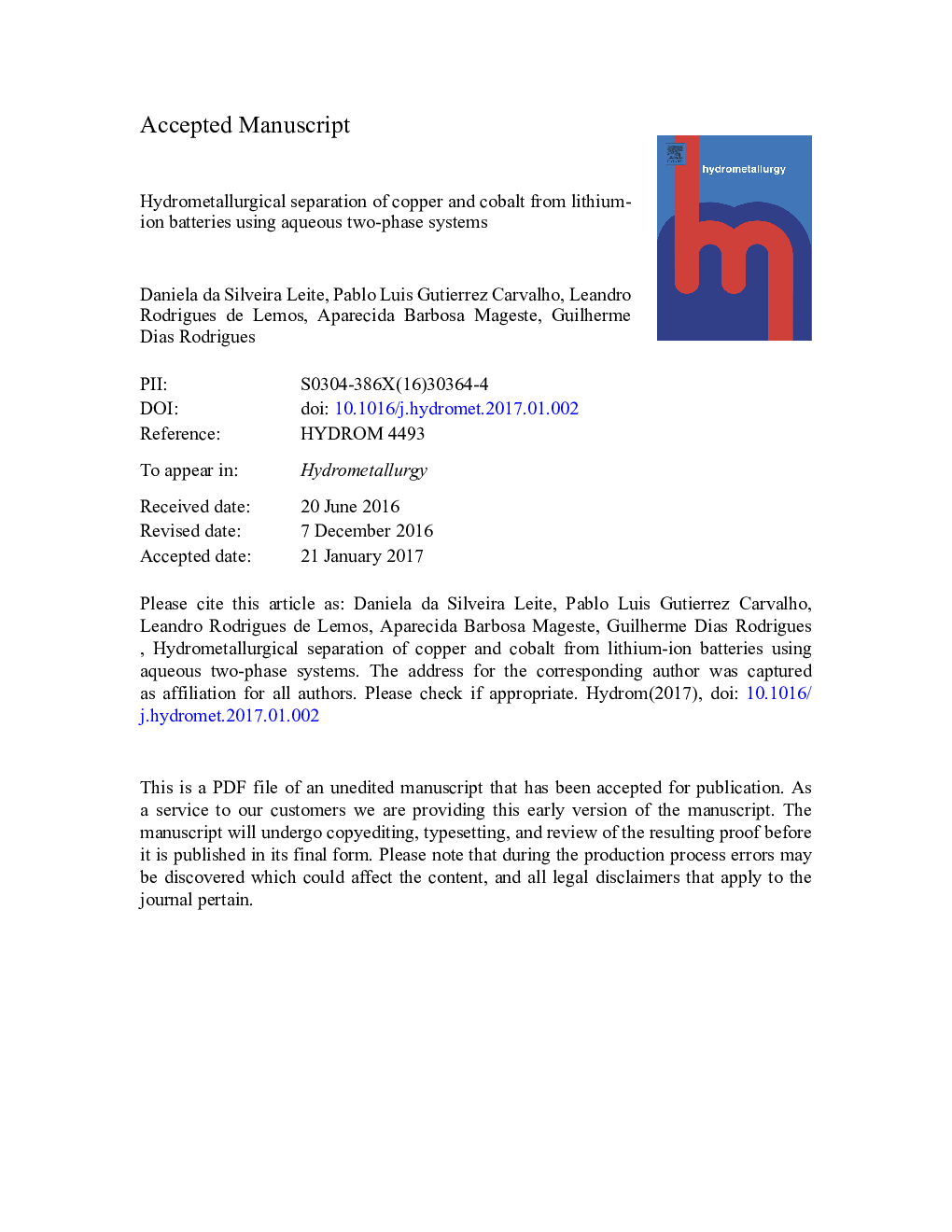| کد مقاله | کد نشریه | سال انتشار | مقاله انگلیسی | نسخه تمام متن |
|---|---|---|---|---|
| 4769333 | 1425535 | 2017 | 44 صفحه PDF | دانلود رایگان |
عنوان انگلیسی مقاله ISI
Hydrometallurgical separation of copper and cobalt from lithium-ion batteries using aqueous two-phase systems
ترجمه فارسی عنوان
جداسازی هیدرومغناطیسی مس و کبالت از باتری های لیتیوم یون با استفاده از سیستم های دو فازی آبی
دانلود مقاله + سفارش ترجمه
دانلود مقاله ISI انگلیسی
رایگان برای ایرانیان
کلمات کلیدی
1-Nitroso-2-naphtholTie-line lengthTLLFAASATPSEPALIBS - LIBS هاEnvironmental Protection Agency - آژانس حفاظت از محیط زیستSolvent extraction - استخراج حلالLiquid-liquid extraction - استخراج مایع _ مایعlithium-ion batteries - باتری های لیتیوم یونe-waste - زباله های الکترونیکیaqueous two-phase system - سیستم دوفازی آبیAqueous two-phase systems - سیستم های دو مرحله ای آبیElectronic waste - ضایعات الکترونیکیFlame atomic absorption spectrometry - طیف سنجی جذب اتمی شعلهPAN - ماهی تابهCopper - مسCobalt - کبالت
موضوعات مرتبط
مهندسی و علوم پایه
مهندسی شیمی
مهندسی شیمی (عمومی)
چکیده انگلیسی
A new green hydrometallurgical method was developed for the selective extraction of copper and cobalt from spent lithium-ion batteries, using an aqueous two-phase system (ATPS) extraction technique. The method was optimized for the extraction of Cu(II) and Co(II), considering the influence of the following parameters: type and concentration of extractant (1-(2-pyridyl-azo)-2-naphthol (PAN), 1-nitroso-2-naphthol (1N2N), or bis(2,4,4-trimethylpentyl) phosphinic acid (Cyanex 272)); pH (1.00, 6.00, or 11.0); ATPS-forming electrolyte (Na2SO4 or Na3C6H5O7); tie-line length (TLL) of the system; and mass ratio of the top and bottom phases (mTP/mBP). The recovery efficiency was evaluated in terms of the extraction percentage (%E) and the separation factor (S) between copper and cobalt. The best conditions for selective extraction were achieved using an ATPS composed of L64 + Na2SO4 + H2O, with pH = 6.00, TLL = 50.3% (w/w), mTP/mBP = 1, and PAN as the extracting agent, which resulted in βCu,Co = 3.22 Ã 102. The method was subsequently applied to a real lithium-ion battery sample, previously leached with HCl and HNO3. Improved separation of copper and cobalt was achieved using successive extraction steps, resulting in βCu,Co = 5.40 Ã 105. A stripping assay was also performed, and after a single step, 70.5% of the copper was available for an electrowinning process.
ناشر
Database: Elsevier - ScienceDirect (ساینس دایرکت)
Journal: Hydrometallurgy - Volume 169, May 2017, Pages 245-252
Journal: Hydrometallurgy - Volume 169, May 2017, Pages 245-252
نویسندگان
Daniela da Silveira Leite, Pablo Luis Gutierrez Carvalho, Leandro Rodrigues de Lemos, Aparecida Barbosa Mageste, Guilherme Dias Rodrigues,
